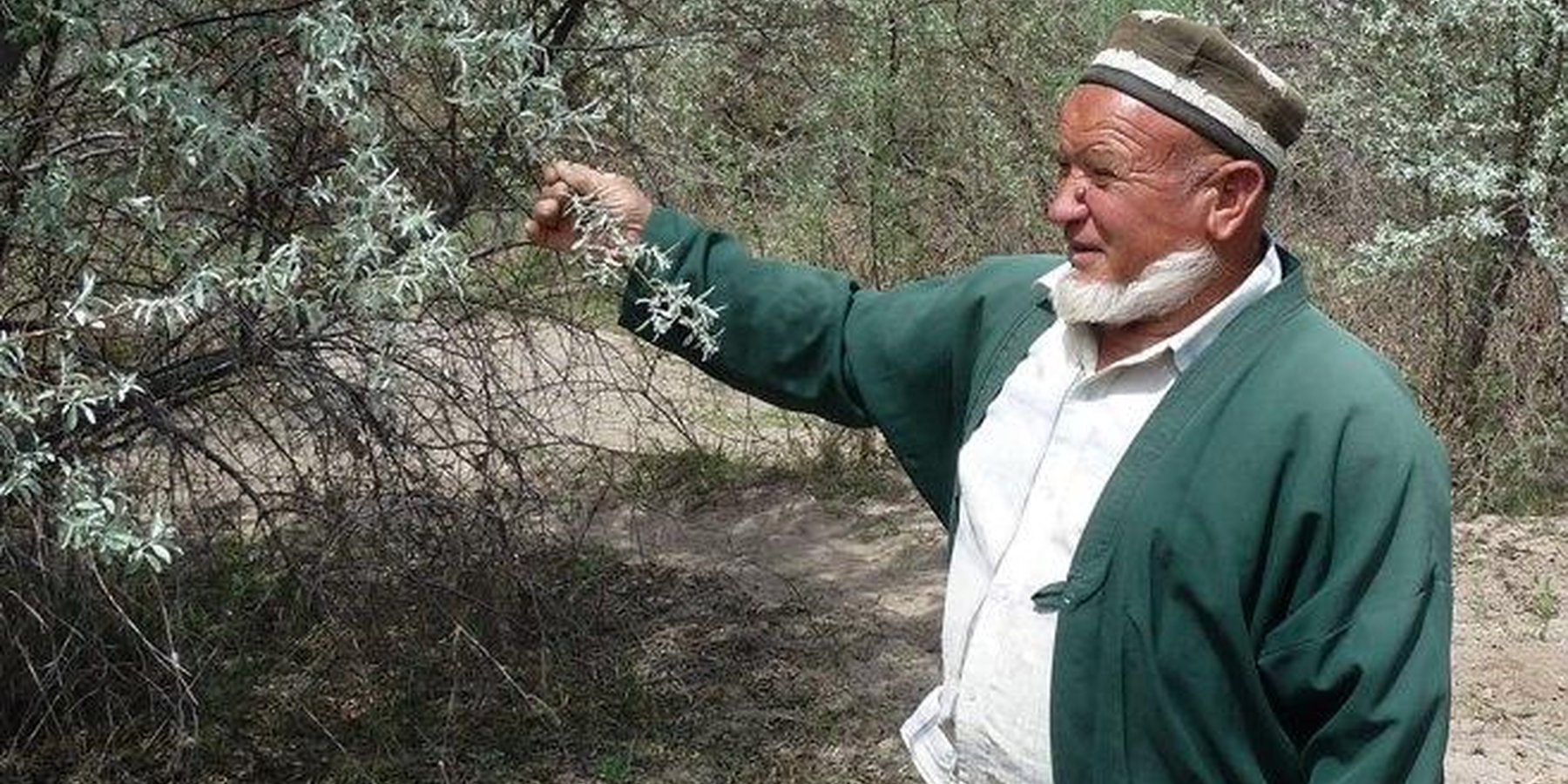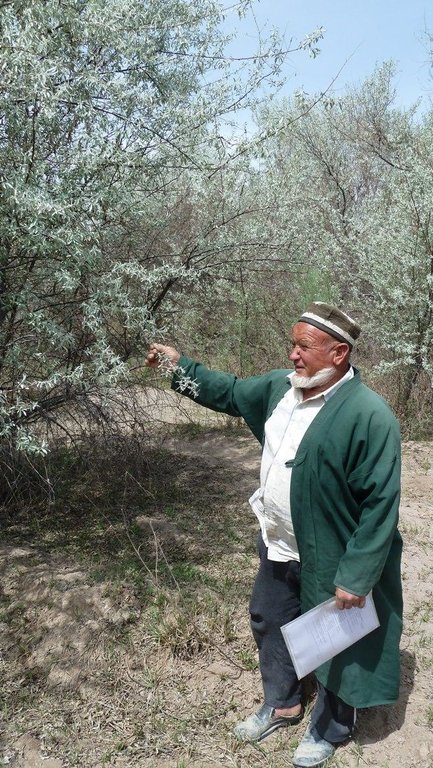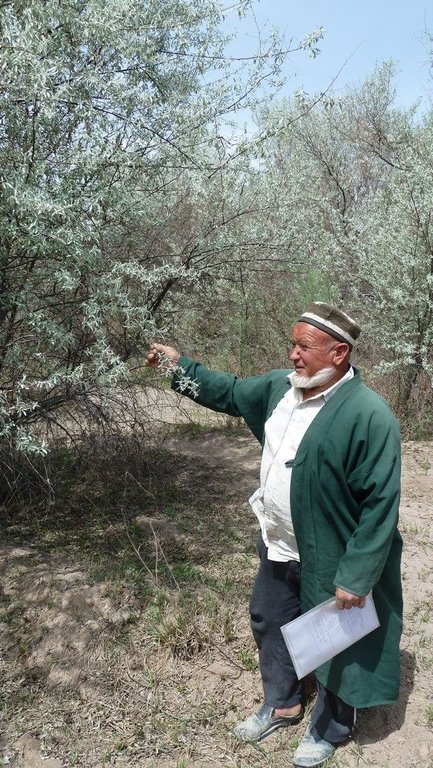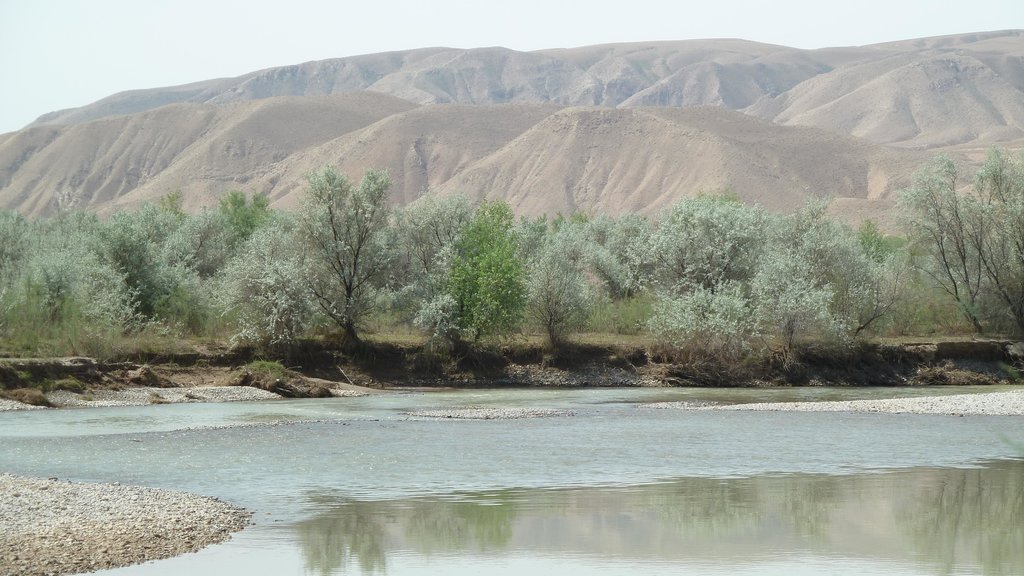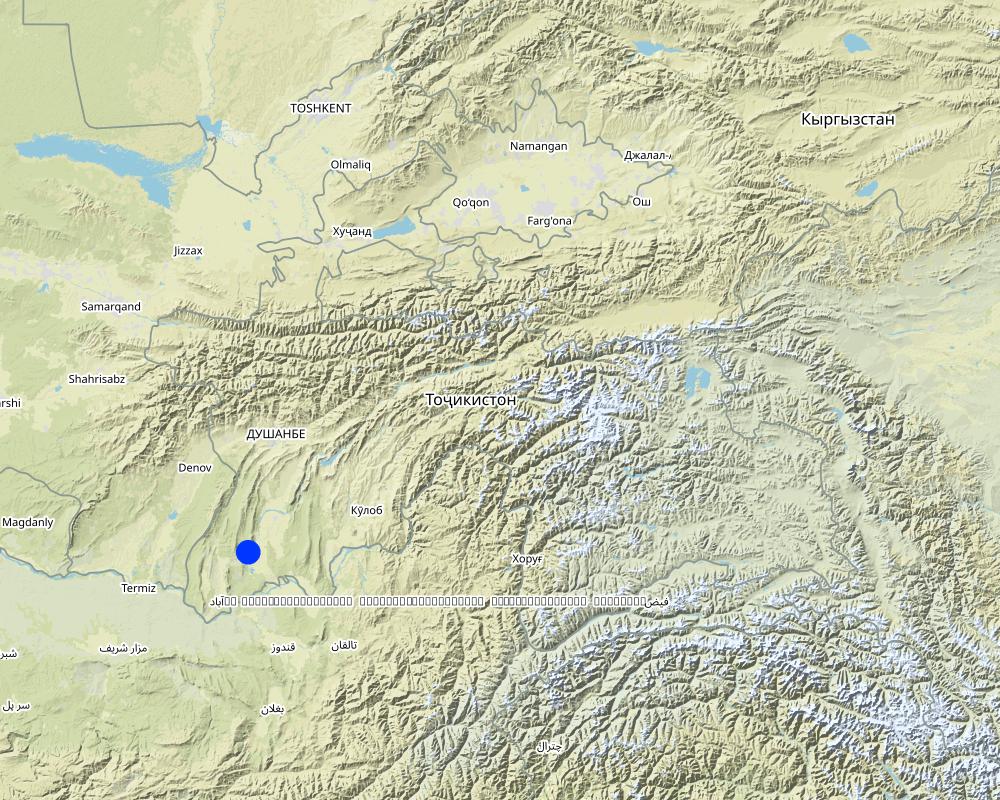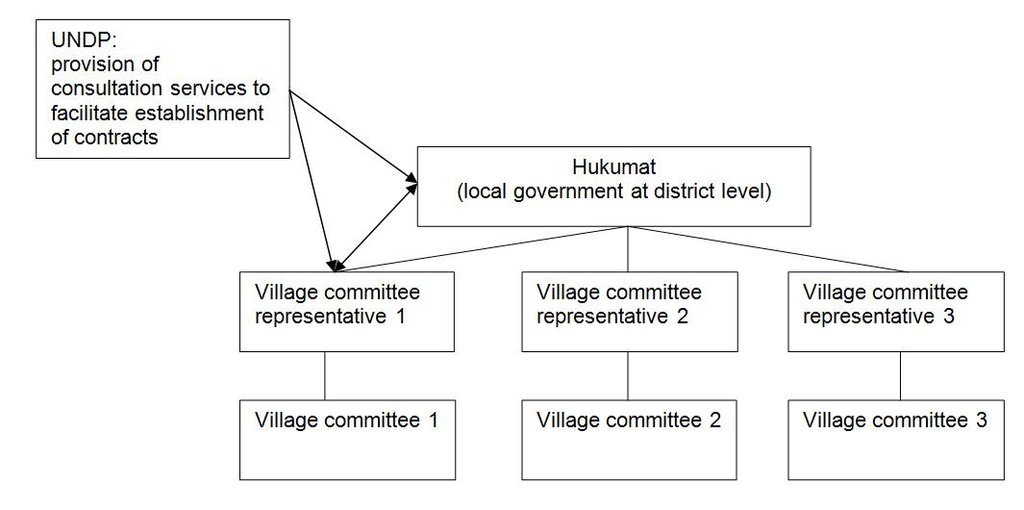Tugai forest management through village committees [Tadjikistan]
- Création :
- Mise à jour :
- Compilateur : Firdavs Faizulloev
- Rédacteur : –
- Examinateurs : David Streiff, Alexandra Gavilano, Joana Eichenberger
approaches_2441 - Tadjikistan
Voir les sections
Développer tout Réduire tout1. Informations générales
1.2 Coordonnées des personnes-ressources et des institutions impliquées dans l'évaluation et la documentation de l'Approche
Spécialiste GDT:
Spécialiste GDT:
Spécialiste GDT:
Abdurakhimov Najmiddin
najmiddin.abdurakhimov@undp.org
National Expert on Forestry, UNDP
Shaartuz Area Office, 2 Ziyodaliev Street, Shaartuz
Tadjikistan
Nom du projet qui a facilité la documentation/ l'évaluation de l'Approche (si pertinent)
Pilot Program for Climate Resilience, Tajikistan (WB / PPCR)Nom du ou des institutions qui ont facilité la documentation/ l'évaluation de l'Approche (si pertinent)
Central Asian Countries Initiative for Sustainable Land Management - Multicountry Capacity Building (CACILM - MCB) - KirghizistanNom du ou des institutions qui ont facilité la documentation/ l'évaluation de l'Approche (si pertinent)
CDE Centre for Development and Environment (CDE Centre for Development and Environment) - SuisseNom du ou des institutions qui ont facilité la documentation/ l'évaluation de l'Approche (si pertinent)
United Nations Development Program (United Nations Development Program) - Tadjikistan1.3 Conditions relatives à l'utilisation par WOCAT des données documentées
Quand les données ont-elles été compilées (sur le terrain)?
13/04/2011
Le compilateur et la(les) personne(s) ressource(s) acceptent les conditions relatives à l'utilisation par WOCAT des données documentées:
Oui
2. Description de l'Approche de GDT
2.1 Courte description de l'Approche
The described approach facilitates the establishment of contracts between village committees and local authorities for decentralised management of Tugai forest areas on State Reserve Land.
2.2 Description détaillée de l'Approche
Description détaillée de l'Approche:
Aims / objectives: Tugai forests are riparian forest ecosystems situated in the continental, winter-cold deserts of Central Asia. These flood plain forests are severely threatened by overexploitation for fire wood and by overgrazing. The 253 ha of Tugai forest in Nuri Vakhsh Jamoat along the Vakhsh river in southern Tajikstan were suffering due to their de facto status as open access resources. The district environmental department that was supposed to monitor the forest was unable to effectively carry out this work. Therefore the UNDP project on “Demonstrating Local Responses to Combating Land Degradation and Improving Sustainable Land Management in SW Tajikistan” saw the protection of this Tugai forest as a priority and engaged with local land users to help protect the forest.
Methods: UNDP project representatives held discussions with forest users living in villages next to to the Tugai forests, regarding the establishment of community-based forest management institutions. UNDP proposed that these institutions enter into agreement with the Hukumat (local district-level government) to protect and exclusively use well defined forest areas on nearby State Reserve Land.
Stages of implementation: As a first step, UNDP obtained permission from the Hukumat to conduct sanitary felling of dry and infected trees, to help improve the forest structure under supervision of the Jamoat (local municipality-level government). The removed tree material was distributed to schools and hospitals as fire wood. Next, a leasehold agreement was formed between a representative of each of the three village committees and the Hukumat. These leasehold agreements covered a total of 126 ha out of 253 ha of Tugai forest existing in the area and they are valid for five years. The remaining forest area, which is not under an agreement, is not threatened as it is situated on an island in the middle of a strong stream that cannot be crossed. The committee has to pay about or 1.73 USD / ha of leased forest land as a tax to the district. The tax paid is collected from contributions by members of the villages who pay for each head of cattle that they send for grazing at a cost of 1 USD / head of cattle.
Role of stakeholders: The village committees are headed by one representative who is responsible for regulating access to the forest plots. The local Jamoat supervises the activities carried out by the village committees on their respective plots. UNDP provides consulting services for the process of establishing contracts between village committees and the local authorities and is carrying out regular monitoring of the forest management activities.
2.3 Photos de l'approche
2.5 Pays/ région/ lieux où l'Approche a été appliquée
Pays:
Tadjikistan
Région/ Etat/ Province:
Khatlon
Autres spécifications du lieu :
Nuri Vakhsh Jamoat
Commentaires:
Total area of Tugai is 253 ha, of which 126 ha are under leasehold agreement (approach). The rest is still open access, but is not threatened as it is situated in the middle of a strong stream and cattle cannot access it to graze.
Map
×2.6 Dates de début et de fin de l'Approche
Indiquez l'année de démarrage:
2009
Date (année) de fin de l'Approche (si l'Approche n'est plus appliquée):
2011
2.7 Type d'Approche
- fondé sur un projet/ programme
2.8 Principaux objectifs de l'Approche
The Approach focused mainly on SLM with other activities (regulation of access for herders)
The main aim of the approach is to help prevent the degradation of Tugai forest, and the disappeareance of this threatened ecosystem, while giving the local population the chance to manage and use it in a sustainable way.
The SLM Approach addressed the following problems: uncontrolled access and degradation of Tugai forest, overgrazing, cutting of trees, no firewood resources available
2.9 Conditions favorisant ou entravant la mise en œuvre de la(des) Technologie(s) appliquée(s) sous l'Approche
normes et valeurs sociales/ culturelles/ religieuses
- entrave
lack of local level structures enabling collaboration between village organisations and Jamoat or Hukumat
Treatment through the SLM Approach: UNDP assistance and consulting to improve collaboration and enabling the establishment of leasehold agreements
cadre institutionnel
- entrave
no implementation of control and punishment measures regarding the overexploitation of Tugai forest
Treatment through the SLM Approach: clearly defined rights and responsibilities for forest users and village and local government institutions
cadre juridique (régime foncier, droits d'utilisation des terres et de l'eau)
- favorise
The existing land ownership, land use rights / water rights moderately helped the approach implementation: As the land is classified as State Reserve Land, and is under the control of the forestry department within the Hukumat, the establishment of an agreement between village organisations and the Hukumat was possible.
- entrave
no defined forest use or management rights and responsibilities
Treatment through the SLM Approach: user agreement between village committees and district administration
connaissances sur la GDT, accès aux supports techniques
- entrave
overgrazing and overexploitation of Tugai forest for firewood
Treatment through the SLM Approach: the forest leasehold agreement defines that no cutting of trees is allowed during the first 5 years, apart from sanitary felling, and grazing is limited to a certain number of cattle
3. Participation et rôles des parties prenantes impliquées dans l'Approche
3.1 Parties prenantes impliquées dans l'Approche et rôles
- exploitants locaux des terres / communautés locales
Representative of village committee and village committees
Village committees were all represented by men.
- Spécialistes de la GDT/ conseillers agricoles
UNDP consultants
International experts designed the broad structure/framework of the approach, but the specific agreements were designed by village representatives, Hukumat, and the UNDP consultant.
- gouvernement national (planificateurs, décideurs)
District administration
- organisation internationale
UNDP
Si plusieurs parties prenantes sont impliquées, indiquez l'organisme chef de file ou l'institution responsable:
UNDP
3.2 Participation des exploitants locaux des terres/ communautés locales aux différentes phases de l'Approche
| Participation des exploitants locaux des terres/ communautés locales | Spécifiez qui était impliqué et décrivez les activités | |
|---|---|---|
| initiation/ motivation | aucun | Consultants from UNDP initiated the approach and started discussions with villages next to the forest |
| planification | aucun | |
| mise en œuvre | interactive | establishment of village committees, managing access for livestock herders |
| suivi/ évaluation | aucun | monthly monitoring through UNDP consultant |
| Research | aucun |
3.3 Diagramme/ organigramme (si disponible)
Description:
UNDP facilitates the process of establishing contracts between village organisations and the Hukumat for decentralised forest management.
Auteur:
Julie Zähringer (Baumackerstr. 51)
3.4 Prises de décision pour la sélection de la Technologie/ des Technologies
Indiquez qui a décidé de la sélection de la Technologie/ des Technologies à mettre en œuvre:
- principalement les exploitants des terres soutenus par des spécialistes de la GDT
Expliquez:
As technology in this case we understand the implementation of the forest leasehold agreements.
Decisions on the method of implementing the SLM Technology were made by mainly by SLM specialists with consultation of land users. As technology in this case we understand the implementation of the forest leasehold agreements.
4. Soutien technique, renforcement des capacités et gestion des connaissances
4.1 Renforcement des capacités/ formation
Une formation a-t-elle été dispensée aux exploitants des terres/ autres parties prenantes?
Oui
Spécifiez qui a été formé:
- exploitants des terres
Formats de la formation:
- réunions publiques
Thèmes abordés:
forest conservation, sustainable grazing management, sanitary cutting
4.2 Service de conseils
Les exploitants des terres ont-ils accès à un service de conseils?
Oui
Décrivez/ commentez:
Advisory service is quite adequate to ensure the continuation of land conservation activities; The forest leasehold agreements were established for a duration of 5 years. After this, the Hukumat should be in an adequate position to renew or adjust those agreements if necessary.
4.3 Renforcement des institutions (développement organisationnel)
Des institutions ont elles été mises en place ou renforcées par le biais de l'Approche?
- oui, modérément
Spécifiez à quel(s) niveau(x), ces institutions ont été renforcées ou mises en place:
- local
Précisez le type de soutien:
- renforcement des capacités/ formation
Donnez plus de détails:
Jamoat
4.4 Suivi et évaluation
Le suivi et l'évaluation font ils partie de l'Approche? :
Oui
Commentaires:
bio-physical aspects were regular monitored by project staff through measurements; indicators: plant and bird species, number of cases connected with illegal cutting of trees
bio-physical aspects were regular monitored by project staff through observations; indicators: visual assessment of rehabilitation of grass, bushes and trees, number of wild animals and birds
There were no changes in the Approach as a result of monitoring and evaluation: None
There were no changes in the Technology as a result of monitoring and evaluation: None
4.5 Recherche
La recherche a-t-elle fait partie intégrante de l’Approche?
Oui
Spécifiez les thèmes:
- écologie
Donnez plus de détails et indiquez qui a mené ces recherches:
Studies about presence of plant and bird species
5. Financement et soutien matériel externe
5.1 Budget annuel de la composante GDT de l'Approche
Commentez (par ex. principales sources de financement/ principaux bailleurs de fonds):
Approach costs were met by the following donors: international (UNDP): 100.0%
5.2 Soutiens financiers/ matériels fournis aux exploitants des terres
Les exploitants des terres ont-ils reçu un soutien financier/ matériel pour la mise en œuvre de la Technologie/ des Technologies?
Non
5.3 Subventions pour des intrants spécifiques (incluant la main d'œuvre)
- intrants agricoles
| Spécifiez les intrants subventionnés | Dans quelle mesure | Spécifiez les subventions |
|---|---|---|
| entièrement financé | seeds for riverbank afforestation | |
- autre
| Autre (spécifiez) | Dans quelle mesure | Spécifiez les subventions |
|---|---|---|
| costs associated with training and meetings | entièrement financé |
Si la main d'œuvre fournie par les exploitants des terres était un intrant substantiel, elle était:
- volontaire
5.4 Crédits
Des crédits ont-ils été alloués à travers l'Approche pour les activités de GDT?
Non
5.5 Autres incitations ou instruments
D'autres incitations ou instruments ont-ils été utilisés pour promouvoir la mise en œuvre des Technologies de GDT?
Oui
Si oui, spécifiez:
Jamoat
6. Analyses d'impact et conclusions
6.1 Impacts de l'Approche
Est-ce que l'Approche a aidé les exploitants des terres à mettre en œuvre et entretenir les Technologies de GDT?
- Non
- Oui, un peu
- Oui, modérément
- Oui, beaucoup
protection of biodiversity, improved fodder availability
Est-ce que l'Approche a autonomisé les groupes socialement et économiquement défavorisés?
- Non
- Oui, un peu
- Oui, modérément
- Oui, beaucoup
Did other land users / projects adopt the Approach?
- Non
- Oui, un peu
- Oui, modérément
- Oui, beaucoup
the experience has not yet been disseminated
Did the Approach lead to improved livelihoods / human well-being?
- Non
- Oui, un peu
- Oui, modérément
- Oui, beaucoup
improved pasture quality within the forest plots and high aesthetic value of the forest
Did the Approach help to alleviate poverty?
- Non
- Oui, un peu
- Oui, modérément
- Oui, beaucoup
6.2 Principale motivation des exploitants des terres pour mettre en œuvre la GDT
- règles et règlements (amendes)/ application
- conscience environnementale
- améliorer l'esthétique
- well-being and livelihoods improvement
6.3 Durabilité des activités de l'Approche
Les exploitants des terres peuvent-ils poursuivre ce qui a été mis en œuvre par le biais de l'Approche (sans soutien extérieur)?
- oui
Si oui, décrivez de quelle manière:
The land users should now be in a position to renew contracts with the Hukumat.
6.4 Points forts/ avantages de l'Approche
| Points forts/ avantages/ possibilités du point de vue de l'exploitant des terres |
|---|
| Protection of plant and animal diversity |
| Increasing the capacity of the community on legal issues |
| Aesthetic value of the beauty of this landscape - quote from land user responsible for a 41 ha forest plot 'Every morning when I open the window and I see the beautiful landscape of the Tugai forest I feel happy' |
| Points forts/ avantages/ possibilités du point de vue du compilateur ou d'une autre personne ressource clé |
|---|
|
Protection of a highly endangered ecosystem, while allowing for improvement of grazing for local herders |
6.5 Faiblesses/ inconvénients de l'Approche et moyens de les surmonter
| Faiblesses/ inconvénients/ risques du point de vue de l’exploitant des terres | Comment peuvent-ils être surmontés? |
|---|---|
| no tenure security as the government could sell off the land at any time | issue land user certificates |
7. Références et liens
7.1 Méthodes/ sources d'information
- visites de terrain, enquêtes sur le terrain
- interviews/entretiens avec les exploitants des terres
Liens et modules
Développer tout Réduire toutLiens
Aucun lien
Modules
Aucun module trouvé


